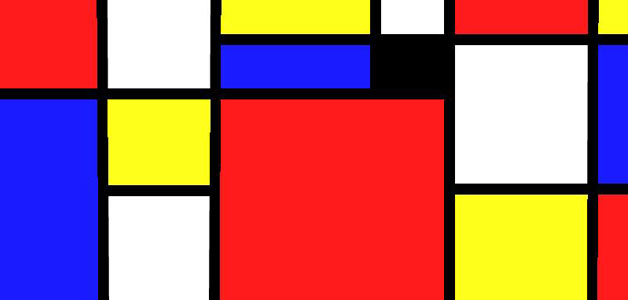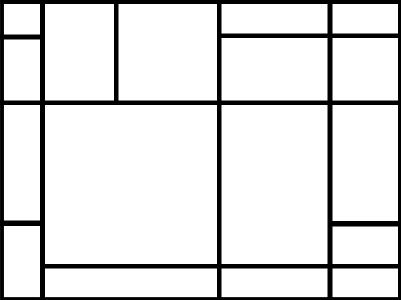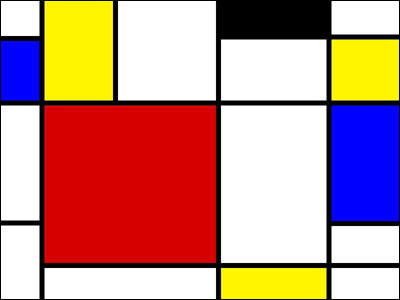
Students color a page in the style of Piet Mondrian and then count, describe, and compare the shapes and colors.

Dutch painter, Piet Mondrian, is best known for his work that used primary colors, white and black in simplified lines and shapes on canvas.
After learning about this amazing artist, students will color a page in his style, count the shapes and colors they used, and describe and compare the components of their work to the work of their classmates.
Introduce your students to the work of Piet Mondrian using materials in your collection. You can also find a selection of images and simple text descriptions you can read to students from Tate Kids.
Open a single image and help students define key terms, including:
Play Jump Steady Blues by Pine Top Smith and let students know that Mondrian loved the Boogie Woogie music he heard when he moved to New York. Then, show students Mondrian’s work Broadway Boogie Woogie.
Share the title of the painting and ask students why they think Mondrian might have titled the work with the name of this type of music. While they aren't developmentally ready for heavy abstract thinking, this is a great way for students to begin responding to, interpreting, and connecting with art.
Provide students with a Mondrian-style coloring page. If you are working remotely, assign a digital Mondrian coloring page students can color with a paint bucket fill tool using an app like Wixie.

Download a printable Mondrian Coloring Page.
Have students use crayons, colored pencils, paint, markers, or a digital paint bucket to fill squares and rectangles with primary colors.
To help them focus on counting and comparing, limit students to primary colors (red, blue, yellow) and black. Let them know they do not have to fill every space with color.
When students are finished coloring their pages, ask them to tally how many squares and rectangles are in their work as well as how many of each color shape they included.
Download and print a Mondrian tally and count worksheet to capture this information so students only have to create tally marks and write numbers.
Have students count the squares, rectangles, and different colors on their coloring page.
When students have completed their count, display one student’s image so the entire class can see it.

Ask students to describe the location of one element, such as:
Repeat this process with additional shapes on additional student samples.
Pair students with a classmate to compare their Mondrians. First, have each pair look at their coloring pages to visually count and compare how many color choices each uses and which has more of each color.
Next, have each team look at the numbers on their tally pages and compare the values numerically, deciding which has more, less, or an equal amount of each color.
To finish, ask students to describe what they liked most about their coloring page, or that of a classmate. Did they enjoy one color more than another? Encourage them to identify specifics as they describe the artwork and their feelings in response to it.
This lesson provides opportunities for both formative and summative assessment in the areas of counting, shapes, and comparing values. It also provides opportunities for building and evaluating common and academic vocabulary, such as knowledge of shape, color and position words.
Analyzing the abstract nature of Mondrian’s art is not appropriate at this age, but having students express how they feel while looking at the repetitive lines and colors is a great way to get young students interested in art appreciation.
Dodds, Dayle Ann and Julie Lacome.The Shape of Things. ISBN-10: 0613000560
Tate Kids - Who is Piet Mondrian?
VA:Cr1.1.K
Engage in exploration and imaginative play with materials.
VA:Cr3.1.Ka
Explain the process of making art while creating.
VA:Re8.1.Ka
Interpret art by identifying subject matter and describing relevant details.
CCSS.MATH.CONTENT.K.CC.A.3
Write numbers from 0 to 20. Represent a number of objects with a written numeral 0-20 (with 0 representing a count of no objects).
CCSS.MATH.CONTENT.K.CC.B.4.A
When counting objects, say the number names in the standard order, pairing each object with one and only one number name and each number name with one and only one object.
CCSS.MATH.CONTENT.K.CC.C.6
CCSS.MATH.CONTENT.K.CC.C.6
Identify whether the number of objects in one group is greater than, less than, or equal to the number of objects in another group, e.g., by using matching and counting strategies.
CCSS.MATH.CONTENT.K.MD.B.3
CCSS.MATH.CONTENT.K.MD.B.3
Classify objects and count the number of objects in each category.
CCSS.MATH.CONTENT.K.G.A.1
Describe objects in the environment using names of shapes, and describe the relative positions of these objects using terms such as above, below, beside, in front of, behind, and next to.
CCSS.MATH.CONTENT.K.G.A.2
Correctly name shapes regardless of their orientations or overall size.
6. Creative Communicator
Students communicate clearly and express themselves creatively for a variety of purposes using the platforms, tools, styles, formats and digital media appropriate to their goals. Students:
a. choose the appropriate platforms and tools for meeting the desired objectives of their creation or communication.
b. create original works or responsibly repurpose or remix digital resources into new creations.
d. publish or present content that customizes the message and medium for their intended audiences.

Follow us on Instagram for daily inspiration

Create a thought web, cluster, flowchart, or other graphic organizer for a lesson
8 first projects to get students using technology
Creative, digital book reviews
Fun and powerful ideas with animated characters

Wixie
Share your ideas, imagination, and understanding through writing, art, voice, and video.

Rubric Maker
Create custom rubrics for your classroom.

Pics4Learning
A curated, copyright-friendly image library that is safe and free for education.

Wriddle
Write, record, and illustrate a sentence.

Get creative classroom ideas delivered straight to your inbox once a month.
Topics